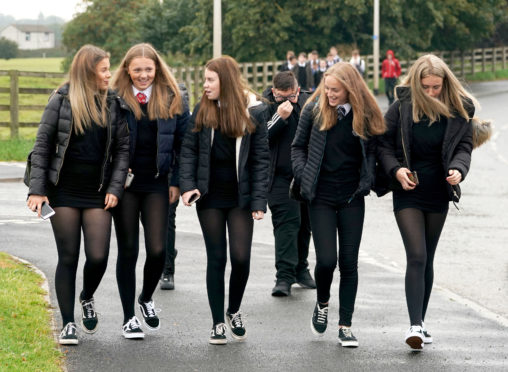
Scots pupils have been sent back to school “like canaries in a mineshaft” to test the safety of the air, a leading expert in respiratory sciences has warned.
Julian Tang is calling for the introduction of carbon dioxide monitors to classrooms as an easy way of highlighting poor ventilation and a heightened risk of airborne Covid-19 transmission.
Dr Tang, honorary associate professor in the department of respiratory sciences at Leicester University and a hospital consultant, said: “We have put Scottish pupils in the experimental bracket. They are being used like canaries sent down a mineshaft ahead of the miners.”
About 698,000 children returned to primary and secondary schools in Scotland last week. One primary school in Peterhead had to close after a case of Covid. And an investigation has been launched after five pupils at two high schools in Coatbridge tested positive, two after briefly attending classes.
Dr Tang was one of 239 international experts who last month challenged the World Health Organisation (WHO) over its downplaying of the role of airborne transmission in the spread of the coronavirus.
This type of transmission involves tiny particles, possibly produced by talking, that can remain suspended in the air for some time. WHO subsequently conceded aerosol transmission in “crowded, closed and poorly ventilated settings could not be ruled out”. Poor ventilation occurs when polluted air is not replaced by fresh air. One main pollutant of indoor air space is carbon dioxide (CO2), generated by breathing and talking.
Dr Tang urged the use of monitors to measure levels found in indoor settings, such as schools, to warn teachers when ventilation was poor. He said: “CO2, which can be measured by a monitor, is an indicator of how poorly ventilated the air in a classroom is. If it goes up, then there is less ventilation and less fresh air. Any virus in the air will stay there longer at higher concentrations.”
The other form of transmission is through contact with surfaces contaminated by large droplets generated by sneezing and coughing. But, according to the UK Government’s Scientific Advisory Group for Emergencies, no more than 20% of transmission from any respiratory virus is due to this form of transmission. Dr Tang said: “Airborne transmission is much more important than contact transmission.”
Last week the WHO backed the use of CO2 monitors, saying: “Accurate control of critical indoor environmental parameters by a carbon dioxide monitor is a key parameter for the wellbeing and comfort of building occupants. In general, we can say carbon dioxide levels can be used as a rough indicator of the effectiveness of ventilation and as an indicator for excessive population density and overcrowding.”
Dr Tang’s call for CO2 monitors in classrooms was backed by Dr Stirling Howieson, senior lecturer in the department of architecture at Strathclyde University. He said: “Without some type of sensor it is impossible for any teacher to gauge whether levels of ventilation are adequate. My hunch is that, when children go back to school, we will find out whether they infect each other and bring the virus back to their parents and grandparents. We now have a live ‘lab rat’ experiment in progress.
“Keeping 30 children socially distanced in a relatively small classroom is impossible and, where that classroom is under-ventilated and therefore hot and humid, the possibility and rate of transmission will undoubtedly increase.”
The latest guidance from the Scottish Government’s Education Recovery Group advises “schools should ensure adequate levels of ventilation through mechanical ventilation systems or through natural ventilation allowing fresh air to come inside through open windows and doors.” But the Government currently had no recommendations on the use of CO2 monitors.
Last week First Minister Nicola Sturgeon visited West Calder High School, in West Lothian, to see for herself the preparations in place to bring pupils back safely.
Afterwards she said: “I was really impressed and reassured this morning by what I saw of the preparations at West Calder and I know these are being repeated in schools all across the country. I think it is worth saying that, for students and staff, school will feel different to how it was before.”
Guidance issued last week by the Federation of European Heating, Ventilation and Air Conditioning Associations said: “In many European schools sufficient ventilation is a challenge. Sufficient natural ventilation (through open windows) can not be guaranteed at all times.”
It urged installation in classrooms of CO2 monitors with traffic-light indicators “at least in schools where ventilation depends on opening windows and/or grids”.
The Chartered Institution of Building Services Engineers has so far not issued any advice dedicated to schools, while current building regulations only stipulate CO2 monitors be installed in new-build housing.
Glasgow City Council said: “Our officers would not advocate the supply and installation of CO2 sensors. We are doing everything possible to create a supply of fresh air and CO2 monitors will not assist with this.”
The recommended maximum level of carbon dioxide in indoor air is 1,000 parts per million (ppm). Some years ago Strathclyde University investigated levels in classrooms in six schools in Glasgow and found levels of 3,000ppm in those that had been refurbished, had small classrooms and that were under-ventilated to keep them warm. Schools in old Victorian buildings with large rooms, high ceilings and draughty windows had lower levels of CO2.
Dr Howieson said: “It will be interesting to see over the next six months whether one type of school is significantly different than another in terms of virus transmission rates.”

Enjoy the convenience of having The Sunday Post delivered as a digital ePaper straight to your smartphone, tablet or computer.
Subscribe for only £5.49 a month and enjoy all the benefits of the printed paper as a digital replica.
Subscribe © Fraser Bremner/Scottish Daily Mail/PA Wire
© Fraser Bremner/Scottish Daily Mail/PA Wire